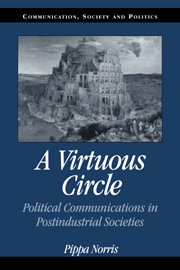Book contents
- Frontmatter
- Contents
- List of Tables
- List of Figures
- Preface
- PART I THE NEWS MEDIA AND CIVIC MALAISE
- PART II TRENDS IN POLITICAL COMMUNICATIONS
- PART III THE IMPACT ON DEMOCRACY
- 9 Negative News, Negative Public?
- 10 Knows Little? Information and Choice
- 11 Cares Less? Cynical Media, Cynical Public?
- 12 Stays Home? Political Mobilization
- 13 American Exceptionalism?
- CONCLUSIONS
- Technical Appendix
- Notes
- Select Bibliography
- Author Index
- Subject Index
12 - Stays Home? Political Mobilization
Published online by Cambridge University Press: 26 February 2010
- Frontmatter
- Contents
- List of Tables
- List of Figures
- Preface
- PART I THE NEWS MEDIA AND CIVIC MALAISE
- PART II TRENDS IN POLITICAL COMMUNICATIONS
- PART III THE IMPACT ON DEMOCRACY
- 9 Negative News, Negative Public?
- 10 Knows Little? Information and Choice
- 11 Cares Less? Cynical Media, Cynical Public?
- 12 Stays Home? Political Mobilization
- 13 American Exceptionalism?
- CONCLUSIONS
- Technical Appendix
- Notes
- Select Bibliography
- Author Index
- Subject Index
Summary
Do newspapers, television and the Internet serve to mobilize voters? Or, instead, do these media reinforce activism? Or even damage civic engagement? The literature remains divided. After outlining the theoretical framework for understanding political participation, this chapter examines the evidence for two issues: What is the impact of traditional political communications on electoral turnout? And, given the explosive increase in the use of new technology, does the Internet have the capacity to play a positive role in civic engagement? The conclusion to this chapter considers the broader implications of the findings.
UNDERSTANDING POLITICAL PARTICIPATION
Explanations of political participation have focused on four sets of factors. The institutional perspective stresses the importance of the legal context, including the extent of political rights and civil liberties, the type of electoral system, the facilities for registration and voting, the extension of the franchise, the frequency, level, and timing of elections, and the competitiveness of electoral politics. In one of the most thorough comparative studies, Jackman and Miller examined voter participation in twenty-two democracies and found that political institutions and electoral laws were the factors that figured most prominently in the most plausible explanation for variations in voter turnout, including levels of electoral participation and proportionality, multi-partyism, and compulsory voting. Franklin, Van der Eijk, and Oppenhuis have argued that the variations in participation in European elections can be attributed in large part to differences in systemic factors, notably the use of compulsory voting, the proportionality of the electoral system, and the temporal proximity of European elections to national elections.
- Type
- Chapter
- Information
- A Virtuous CirclePolitical Communications in Postindustrial Societies, pp. 255 - 278Publisher: Cambridge University PressPrint publication year: 2000



